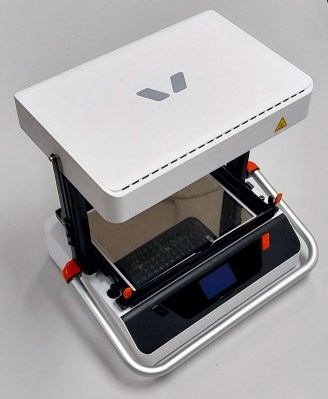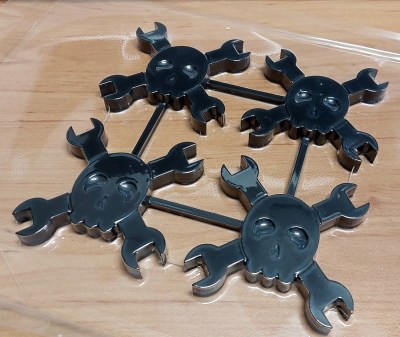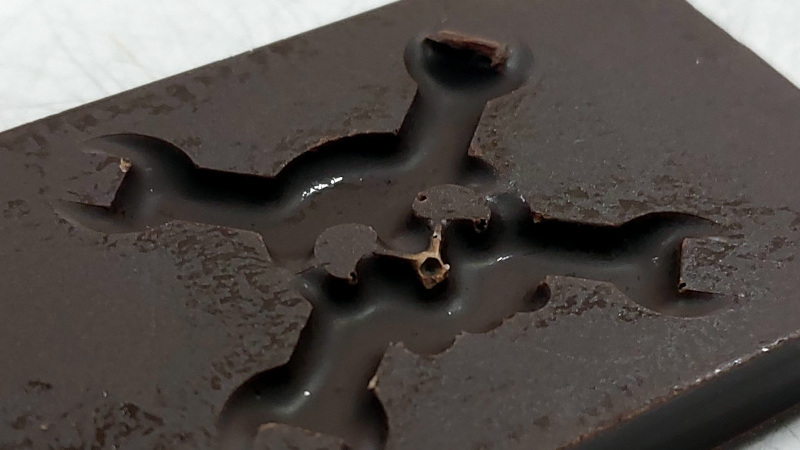What do you do when you find some friends have bought a vacuum forming machine? Make novelty chocolates and ice cubes, of course! This was my response when I had the opportunity to play with a Vaquform DT2 all-in-one vacuum forming machine, so what follows is partly a short review of an exciting machine, and partly an account of my adventures in edible merchandise creation.

Vacuum forming, the practice of drawing a sheet of heat-softened plastic film over a model to make a plastic shell copy of it, is nothing new in our community. It’s most often found in hackerspaces in the form of home made vacuum forming tables, and usually requires quite a bit of experimentation to get good results. The Vaquform machine I was lucky enough to be able to try is an all in one machine that puts the whole process into a compact desktop machine of similar size to a typical 3D printer. It’s a machine of two parts with a moveable carriage between them for the plastic sheet; a vacuum table on its base, and a heater unit suspended above it. The unique selling point is that it’s an all-in-one computer controlled unit that does as much as possible for you, it simply requires the user to place a sheet in the carriage and follow the instructions.
When I first saw the machine I didn’t really have anything to try it with, so of course I resorted to producing a Wrencher or two. Because what it makes are essentially moulds, it made sense to produce something Wrencher-shaped with them, and thus the chocolate and ice plan formed. The first mould was made with laser-cut Wrenchers in 2mm acrylic, stacked on two more layers of uncut acrylic to make a bar with an inset Wrencher on top, while the second one used a 3D-printed array of larger stand-alone Wrenchers with channels between them. Would my first attempt at vacuum forming make usable moulds or not? Only one way to find out.

Using the Vaquform should be entirely straightforward to anyone who has used a modern 3D printer or similar. The LCD screen provides an easy to navigate set of steps for selecting material, thickness, and temperature, then it’s a case of loading the sheet, moving the carriage up when asked, and placing the object to be moulded on the vacuum table. The heater takes a minute or so to get the sheet up to temperature and it follows the appropriate heat profile for the material selected, then the vacuum pump starts up and you’re instructed to move the carriage down onto the table. The whole process of forming the shape is extremely quick, after which all that remains is to part model and mould. You’re left with the full sheet with edges in the shape of the edge of the carriage, and it then remains to trim to shape.

In my case I was using food-safe 0.3 mm HDPE, and in both cases I made good quality moulds with clear definition of features. My models didn’t have full chamfering for easy mould removal, but the Wrencher isn’t complex enough to cause too many problems in that respect.
It was then time to play with food and see what I could make. In practice, the bar-shaped moulds had insufficient resolution for ice but worked well with chocolate, while the standalone Wrenchers made good sturdy ice for my cola. I’ll bring them out for my hackerspace, and maybe delight my colleagues with them next time we get together.
The Vaquform DT2 then. It’s not cheap, being listed currently at $1,150, but it’s an extremely easy to use and convenient machine that certainly delivered on my expectations. It seems solidly built and the software was very straightforward in its instructions, and I went from zero to Wrencher mould in only a few minutes. If I was in the market for a vacuum former and I had the money, it wouldn’t be a difficult decision to buy one.
Coincidentally, we covered the Vaquform when it was still a Kickstarter, just because we think it’s an underrated fabrication method. And if you want to build your own, we’ve seen small and sweet formers, as well as this monster from the past. In the end, it’s a heating element and a table with holes in it, though. Post up your favorite builds in the comments.















Is there many hacking/making use cases for this machine besides ice trays and food molds ? Genuinely curious as I like the technology but it’s always seemed to be more suited for artistic builds than technical ones
Not with this machine but with one larger you can make boxes or dividers for your board games. If you want modularity you can stack small forms inside a drawer or with one large enough you can make tool inserts for an entire drawer….
Other use is waterproof battery pack enclosures as seen on YT.
We use vacu-formed trays as part of the packaging of products at work, that’s the most common use case I can see these days (especially figures, toys, and the like)
I remember at uni we had a project that used a vacu-formed body for a custom radio controlled car, it’s probably fallen out of favour for injection moulded parts but still can give a nice prototype or small product run.
there is no reason you can’t use it instead of injection moulding for products if you have the right design, you can even build in living hinges and snap/catch features and make a single piece case for your projects. maybe a nice blinken lights filled christmas tree could work as well.
Before returning the machine to your friend, you could have cranked out bunch more mo[u]lds to sell on Tindie!
B^)
Any DIY way to mold your own tools?
I have seen guys melting aluminium with termite reaction, if the molds are resistant enough that could be a way.
“termite reaction” ?
Thermite – they just screwed up, lol
Had a lot of fun with Vac-U-Form back in the 60s… and some minor burns.. 😁
https://en.wikipedia.org/wiki/Vac-U-Form
I’d like someone to make a mould or two form. I’d like molds to make hempcrete and to grow mycelium on hemp fiber. This is what I do in my spare time.